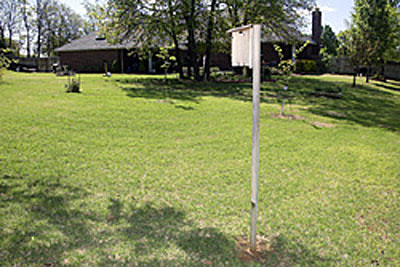
Bluebirds are State birds for the following states: Nevada, Idaho, Missouri and New York
Your chances of attracting bluebirds to your nest box are affected by both where you place your nest box and when it is opened for the year.
When
When you put up or open your bluebird box depends on your location. Bluebird boxes should typically be in place by mid-March. If you reside in the southern states where bluebirds are year-round residents, early March is a good time.
Learn more: How to attract bluebirds
In cooler, wetter years, nesting may start later than usual. Don’t worry if you are a little late in getting your house up; not all pairs form up and start nesting early and there is always the opportunity to accommodate the 2nd or 3rd brood for the year.
Related: Bluebird vs Blue-Jay
Patience is a virtue. It may take 2 or 3 years for the bluebirds to first use your nest box. Make sure the box is clean and dry on the inside each spring. If bluebirds or other native nesters do not move in, you may wish to close or take down the nest box for the season to prevent house sparrows from taking up residence.
Where
Bluebird boxes are often pole mounted. Smooth round pipe may be the best choice and is available from almost any hardware store. Wooden poles are also acceptable and widely used. The entrance to the nesting box should be about 5-6 feet above the ground.
Face the box away from prevailing winds. There is some evidence (study done with eastern bluebirds) that boxes facing east have somewhat better success ratios but local conditions are always important.
Related: Bluebird Symbolism & Meaning
Ideally, boxes should face toward a tree or shrub which is within 100 feet of the box. This provides easy access for young birds leaving the nest. Some advocate placing a man-made perch 15-20 feet in front of the nest box to provide an easy landing spot for young birds if no natural perch is nearby. (Never place a perch directly on the house itself.)
Bluebirds are most common in rural areas and in the outer edges of suburban developments. Locate your bluebird box in an area relatively free from underbrush, in the open, but near a wooded area. Bluebirds like to perch on a tree limb or telephone wire and observe the open fields, golf courses, meadows or other open ground for the insects on which they feed.
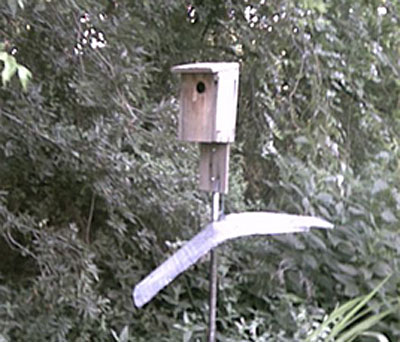
This successful box is located at the edge of a heavily wooded area in a city park. Normally it would be better to locate it in a more open area but this location avoids conflicts with the mowers on their large tractors.
Boxes located near shrubbery and undergrowth tend to be inviting to house wrens and are often more visited by predators.
If raccoons or cats might be present, avoid locating your nest box along a fence line or on a fence post. You may find it necessary to use a baffle or greased pole in any case.
Read Also: Female vs Male Bluebirds
If you establish your own bluebird trail, try to locate your boxes 200 or more yards away from man-made structures such as buildings, bridges and major power poles. This will help limit intrusion by house sparrows, which compete with the bluebirds for nesting locations.
Designs
Once you have decided to put up your own bluebird box, you can either build it yourself or purchase one of several commercial designs.
A good bluebird box should be easy to monitor and to clean out. It should be well ventilated but resistant to water leaking into the nesting area. Untreated cedar or redwood are preferred materials but plywood and even PVC pipe can be used. You can paint or stain the outside of your box (use a light color) but leave the inside untreated.
Building your own bluebird box can be fun and makes an excellent family or school project. Materials can be purchased from your local lumber yard for less than $10.00.
Please do not put up a bluebird box unless you are committed to monitoring it and preventing house sparrows from nesting. Choosing a box with the correct hole size will prevent starlings from using the nest box.
Bluebird Box Design
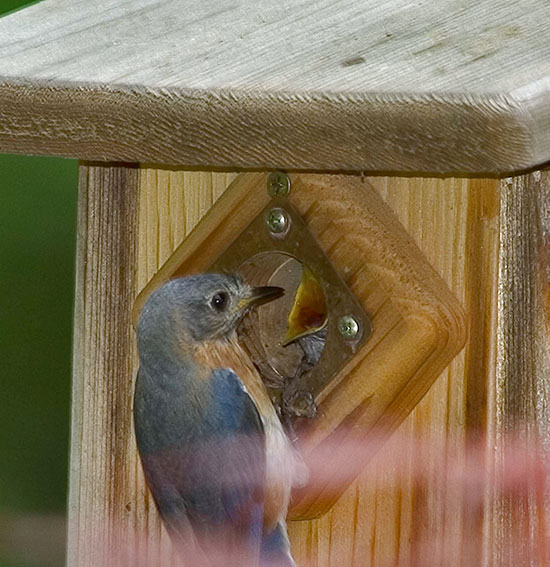
There are many different designs of bluebird boxes and each one has its supporters. Almost any style will do but boxes that conform to the following guidelines are most likely to be successful.
Styles and sizes:
Commercially produced boxes are available in a variety of designs and styles. Look for houses that have been approved by the North American Bluebird Society. If the nest box does not have NABS approval, then check for the following dimensions.
Entrance Hole:
- Eastern Bluebird: 1 1/2 inch round holes, 1 3/8 x 2 1/4 inch vertical oval holes, or 1 1/8 inch horizontal slot entrances.
- Western or Mountain Bluebird: 1 9/16 inch round opening.
- Where ranges overlap, use a 1 9/16 inch round opening.
Floor Size:
- Eastern Bluebird: 4″ x 4″ or 5″ x 5″ , or 4″ in diameter for circular boxes. Peterson style boxes may be slightly smaller.
- Western or Mountain Bluebird: 5″ x 5″ or 5 1/2″ x 5 1/2″
– A design with a 5 in. front overhang will discourage predators from accessing the nesting area from above.
– Boxes should be watertight but have good ventilation.
– Boxes should be easy to open and close to allow for easy checking of the nest and removal of old nesting material.
Visit the bluebird Box Styles page for more information.
Too lazy to build one? These are the best birdhouses on the market today (incl. bluebird houses).
Additional considerations
- A design with a 5 in. front overhang will discourage predators from accessing the nesting area from above.
- Boxes should be watertight but have good ventilation.
- Boxes should be easy to open and close to allow for easy checking of the nest and removal of old nesting material.
These are several of the more popular styles of bluebird boxes.
Standard
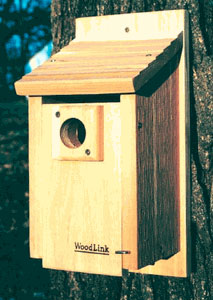
This box is similar in design to the standard NABS box, but includes an extension on the front of the hole to serve as a predator guard.
“Peterson” style box
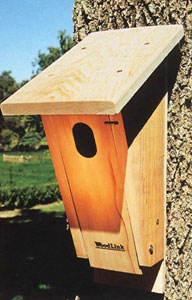
The slant-fronted “Peterson” style box has become popular in many areas. Some research suggests house sparrows seem to avoid the oval-shaped hole while starlings do not like the smaller internal nest size.
PVC Bluebird House
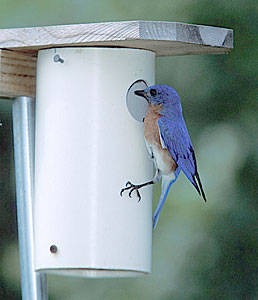
PVC bluebird houses are easy to build, just make sure your design allows easy access to the inside of the nest box. Some reports indicate that house sparrows are less found of PVC houses than they are of more traditional designs.

